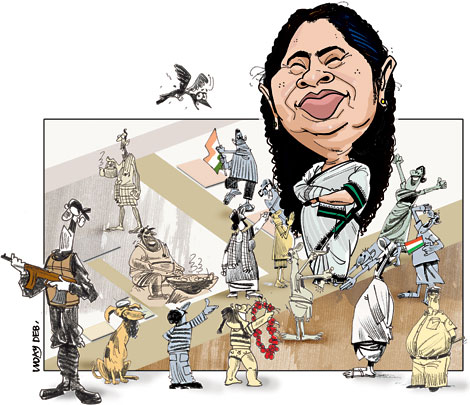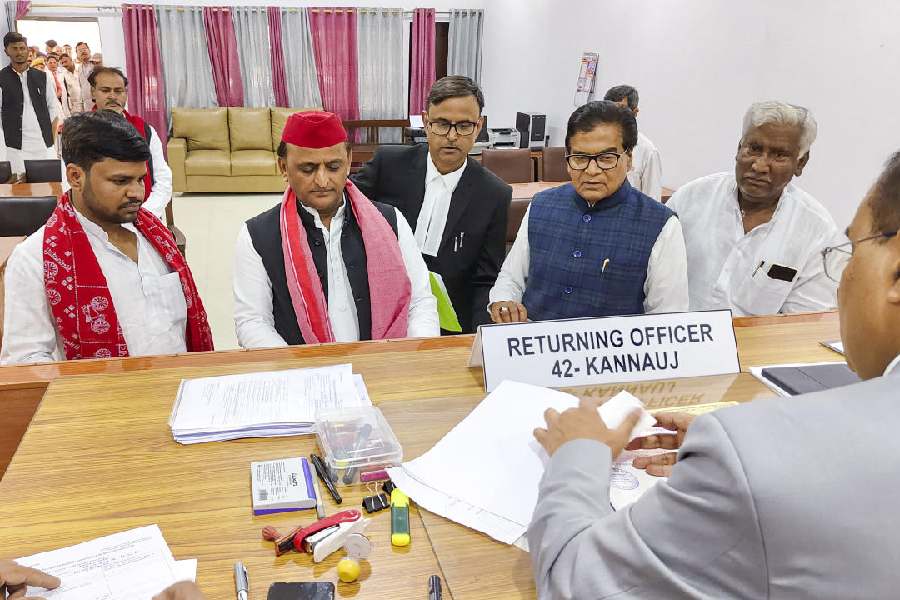 |
On her way back home one day, Mamata Banerjee spotted a stray dog under a tea-stall near her house in Harish Chatterjee Lane. It looked unfed. Banerjee pressed a 50-rupee note into the hands of the tea-stall owner and asked him to feed the dog biscuits worth Rs 2 every day.
That would take care of 25 days. Many more days have passed since, but the brown-and-white dog still gets his daily ration of biscuits — and more. Laden — for that’s what Didi named him — is the favourite dog of the neighbourhood, well fed, well looked after, welcome in every bylane or shop that lines Harish Chatterjee Street, Mamata’s address for 40-odd years.
Does the Trinamul Congress chief still pay for the biscuits? The stall-owner laughs. “Sometimes she does,” he says. He is only too glad that Didi chose him for the job. Her wish is command here.
It always was. But since her victory in the Lok Sabha elections, Mamata’s immediate neighbourhood looks different.
Security personnel crowd around her house and the adjacent Trinamul Congress office. The footfall in Harish Chatterjee Street on an average day may not be comparable with the number of people visiting the Kali temple — though on the day of her victory thousands descended on Mamata’s house and the party office — but it is significant.
Since V-Day Shyamal Das, who runs Bijoydir Ma Hindu Hotel on the street, is thinking about turning his hotel into a snack shop. “Tea and singara are in demand now.” Two chop stalls do brisk business, because Mamata is fond of their alur chop and muri, which has added to the popularity of the shops.
If Kalighat is sacred to Goddess Kali, Harish Chatterjee Street is a temple to Mamata Banerjee, which lies next to the Kalighat bridge, where women with painted faces line up every evening offering pleasure for cheap.
In the neighbourhood, Didi is only second to Goddess Kali. It is probably only a coincidence that in her spare time, when Mamata is an amateur painter, she draws pictures of the goddess.
Many of Didi’s visitors, a number of them from the villages, often drop in after a visit at the Kali temple. “Many people from the districts and villages, after visiting Kalighat temple, drop in here,” says a young Trinamul Congress supporter from the locality. “They come for a darshan here too,” he smiles. That could be another confluence of “Maa, maati, manush”.
Darshan designs
Mamata’s party is considering constructing a temporary gallery in the open space in front of her house for more organised “darshans”.
“We had built a shamiana in the open space for a few days after the election results, but as followers, party workers, peasants and workers from far-flung districts have started pouring in we have decided to construct a gallery here for them,” says Madan Mitra, a Trinamul leader, sitting at the office.
 |
| Home truths: Mamata Banerjee’s house on Harish Chatterjee Street. Picture by Anindya Shankar Ray |
The street, a narrow one that turns right from under the Kalighat Bridge when it is approached from Hazra crossing, would look like any old not-upmarket south Calcutta locality, if it had not been for Mamata-worshippers. The Adi Ganga flows, rather does not flow, right behind her house, and the street is chock-a-block with old houses, foundries, garage workshops, small jewellery shops and some shacks inhabited by Hindi-speaking labourers, and only a few signs of “development” in the shape of multi-storeyeds.
Harish Chatterjee Street was renamed Premendra Mitra Sarani, as declared by the Calcutta Municipal Corporation (CMC) plaque where the street begins, after the acclaimed Bengali writer who created Ghanada and whose house, marked by another CMC plaque, stands towards the other end of the street.
But Premendra Mitra doesn’t seem to matter any more. Harish Chatterjee Street it is, and will remain so, it seems, as long as Mamata lives here.
Giant Mamata Banerjee posters and flex boards line the way to Mamata’s residence, a humble brick-and-tile single-storey house, on the left about a hundred metres into the street. Adjacent to the house, further in, in a row, are houses that belong to her brothers, and her party office.
Didi’s role in the neighbourhood is also a bit like that of Goddess Kali.
Despite Delhi sojourns, the problems back home and the railway budget, she remains “the protector” of the people.
“Last week, a man in the neighbourhood died suddenly. It was well past midnight, but Didi met his wife and asked us to help her,” says Bijon Karmakar, a “full-time” Trinamul worker who dabbles in acting, on stage and in TV serials.
Didi often takes a stroll in the neighbourhood after midnight to catch up with her neighbours. “She knows everyone here and remembers to ask after each of us,” says Swapan Ghosh, a member of Sebak Sangha, a local club.
Unlike Goddess Kali, however, the image of Mamata Banerjee is completely whitewashed. Didi, in her locality, can do no wrong.
Her partymen look blank when asked if she had to leave home because of trouble with her brothers, as was widely reported. “It was the creation of the media,” says one. Doesn’t the influx of cars and crowds into the narrow street disturb the residents? Not at all. “Few cars come, except of reporters. Beshir bhag metho manush ashe (Mostly villagers come here),” he adds.
A CPM sympathiser from the locality remembers Mamata’s early days in the street, when apparently she would pick a fight at the drop of a hat to take up the cause of the people living in the shacks. He says she was thought of as a nuisance then, who would interfere in matters such as petty thefts. “But things have changed now,” he adds hastily.
Mohit Dasgupta, another neighbour, says he remembers her brandishing a jhanta (broom) during a quarrel.
Club rules
Mamata certainly has helped the neighbourhood in other ways since then. “A lot of real estate development is taking place here. Slums are being demolished and highrises are coming up,” says Sona Datta, a tea-seller at Balaram Basu Ghat on Adi Ganga. The ghat has been renovated and saw a fresh coat of paint, courtesy Mamata, though the steps that lead to the river remain covered in waste. The river was cleaned up as part of the Ganga Action Plan but things have returned to their earlier state, says Datta.
Mamata has also provided for a number of roadside taps and public toilets. “There’s no dearth of water here and she made provisions for street lights,” says 52-year-old Jagadish Basu, a frail man chatting with friends at Sebak Sangha Club.
But Goddess Kali has again been instrumental in the ways in which Mamata works for her neighbourhood.
Mamata keeps in touch with the local clubs — Kalighat Milan Sangha, with which she and her family have been involved for long, Shaktisri Sporting Club, Adarsha Club, Harish Park Byayam Samiti — all of them in close proximity. The clubs bear signs of Mamata’s patronage the most.
Almost all of them come with plaques that announce a bounty from the MP Local Area Development fund. (They also have identical neon boards, a gift from a cigarette company whose name is not mentioned, announcing the club names with the slogan: “Jombe adda”.)
Mamata takes care to inaugurate every Puja hosted by the clubs. Kalighat Milan Sangha organises a Durga puja and Sebak Sangha, Tarun Yuvak Sangha and Saptasathi host Kali pujas.
“Didi always inaugurates our Pujas,” says Bijon Karmakar, who is a member of Kalighat Milan Sangha. Holding the Puja is the main activity of the club, says Karmakar, adding that it also has a first division football team.
In return for Didi’s patronage, the clubs look after the area, in ways she thinks best. “Any small problem, and the residents come to us,” says Karmakar. “Only 10 per cent of the problems go to Didi.”
It has borne some results.
Says neighbour Sukla Dey, who has seen Didi since her college days: “While on the face of it Harish Chatterjee Street has remained the same as before, there has been a sea change because of Mamata. Earlier, it used to be a den for hoodlums and drunks but now it is safe even in the dead of the night.”
Picture perfect
Her supporters, of course, will attribute any virtue to Mamata.
Waterlogging remains a problem here, particularly during the high tide, but the water, everyone says, recedes quickly. However, a party worker said that there was no such problem, no shortage of drinking water, not much load-shedding either, suggesting it was due only to Didi’s presence.
“Uni amader bhagaban (She is our god),” declared a young party worker, who said he had grown up seeing “Didi”.
One flex board, installed near Mamata’s house by party members after her victory, proclaims proudly, in English: “She is Venus when she smiles/ But she’s Juno when she walks/ And Minerva when she talks.”
“These are the words of Shelley,” claimed the Trinamul worker.
Mamata Banerjee as a Greek goddess in a strappy white dress is hard to imagine. But as the election graffiti on the walls with her face merge with the faces of Goddess Kali further down the lane, where the Kali pujas are held, one wonders if that is not more appropriate, at least in the eyes of her neighbourhood.
It’s a heavy cross to bear for Mamata. For there’s always the risk of setting one heavy foot on a prostrate Shiva.










